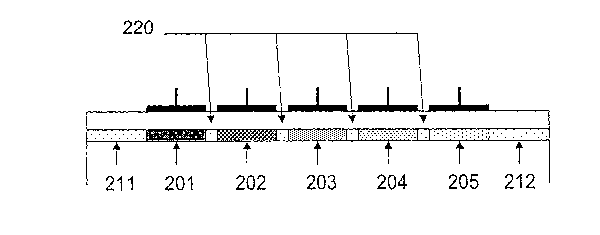Some of the information on this Web page has been provided by external sources. The Government of Canada is not responsible for the accuracy, reliability or currency of the information supplied by external sources. Users wishing to rely upon this information should consult directly with the source of the information. Content provided by external sources is not subject to official languages, privacy and accessibility requirements.
Any discrepancies in the text and image of the Claims and Abstract are due to differing posting times. Text of the Claims and Abstract are posted:
| (12) Patent Application: | (11) CA 2479397 |
|---|---|
| (54) English Title: | ELECTRO-ABSORPTION MODULATOR WITH BROAD OPTICAL BANDWIDTH |
| (54) French Title: | MODULATEUR A ELECTRO-ABSORPTION A GRANDE LARGEUR DE BANDE OPTIQUE |
| Status: | Deemed Abandoned and Beyond the Period of Reinstatement - Pending Response to Notice of Disregarded Communication |
| (51) International Patent Classification (IPC): |
|
|---|---|
| (72) Inventors : |
|
| (73) Owners : |
|
| (71) Applicants : |
|
| (74) Agent: | BORDEN LADNER GERVAIS LLP |
| (74) Associate agent: | |
| (45) Issued: | |
| (86) PCT Filing Date: | 2003-03-14 |
| (87) Open to Public Inspection: | 2003-09-25 |
| Examination requested: | 2008-03-12 |
| Availability of licence: | N/A |
| Dedicated to the Public: | N/A |
| (25) Language of filing: | English |
| Patent Cooperation Treaty (PCT): | Yes |
|---|---|
| (86) PCT Filing Number: | PCT/GB2003/001083 |
| (87) International Publication Number: | WO 2003079100 |
| (85) National Entry: | 2004-09-15 |
| (30) Application Priority Data: | ||||||
|---|---|---|---|---|---|---|
|
An electro-absorption modulator comprises a waveguiding structure including a
plurality of sections (201 - 205), each section having a different bandgap and
at least one electrode for applying electrical bias to the section. An optical
signal passing through the waveguiding structure may be modulated using the
plurality of separately addressable sections, by applying a modulation signal
to one or more of the sections, and electrically biasing one or more of the
sections with a bias voltage, in such a manner as to achieve a predetermined
level of any one or more of the parameters chirp, modulation depth and
insertion loss.
L'invention concerne un modulateur à électro-absorption dont la structure de guide d'onde comprend une pluralité de sections (201 - 205), chaque section ayant une bande interdite différente et au moins une électrode pour appliquer une polarisation électrique à la section. Un signal optique traversant la structure de guide d'onde peut être modulé par la pluralité de sections adressables séparément, un signal de modulation étant appliqué à une ou plusieurs sections et une ou plusieurs sections étant soumise(s) à la tension de polarisation, afin de réaliser un niveau déterminé d'un ou de plusieurs paramètres que sont la fluctuation de longueur d'onde, la profondeur de modulation et la perte d'insertion.
Note: Claims are shown in the official language in which they were submitted.
Note: Descriptions are shown in the official language in which they were submitted.

2024-08-01:As part of the Next Generation Patents (NGP) transition, the Canadian Patents Database (CPD) now contains a more detailed Event History, which replicates the Event Log of our new back-office solution.
Please note that "Inactive:" events refers to events no longer in use in our new back-office solution.
For a clearer understanding of the status of the application/patent presented on this page, the site Disclaimer , as well as the definitions for Patent , Event History , Maintenance Fee and Payment History should be consulted.
| Description | Date |
|---|---|
| Time Limit for Reversal Expired | 2010-03-15 |
| Application Not Reinstated by Deadline | 2010-03-15 |
| Deemed Abandoned - Failure to Respond to Maintenance Fee Notice | 2009-03-16 |
| Letter Sent | 2008-05-14 |
| Request for Examination Received | 2008-03-12 |
| Request for Examination Requirements Determined Compliant | 2008-03-12 |
| All Requirements for Examination Determined Compliant | 2008-03-12 |
| Inactive: IPC from MCD | 2006-03-12 |
| Letter Sent | 2005-06-14 |
| Inactive: Single transfer | 2005-05-16 |
| Letter Sent | 2005-01-12 |
| Inactive: Single transfer | 2004-11-24 |
| Inactive: Cover page published | 2004-11-24 |
| Inactive: Courtesy letter - Evidence | 2004-11-23 |
| Inactive: Notice - National entry - No RFE | 2004-11-16 |
| Application Received - PCT | 2004-10-18 |
| National Entry Requirements Determined Compliant | 2004-09-15 |
| National Entry Requirements Determined Compliant | 2004-09-15 |
| Application Published (Open to Public Inspection) | 2003-09-25 |
| Abandonment Date | Reason | Reinstatement Date |
|---|---|---|
| 2009-03-16 |
The last payment was received on 2008-02-14
Note : If the full payment has not been received on or before the date indicated, a further fee may be required which may be one of the following
Please refer to the CIPO Patent Fees web page to see all current fee amounts.
| Fee Type | Anniversary Year | Due Date | Paid Date |
|---|---|---|---|
| Basic national fee - standard | 2004-09-15 | ||
| Registration of a document | 2004-11-24 | ||
| MF (application, 2nd anniv.) - standard | 02 | 2005-03-14 | 2005-02-16 |
| Registration of a document | 2005-05-16 | ||
| MF (application, 3rd anniv.) - standard | 03 | 2006-03-14 | 2006-02-10 |
| MF (application, 4th anniv.) - standard | 04 | 2007-03-14 | 2007-02-16 |
| MF (application, 5th anniv.) - standard | 05 | 2008-03-14 | 2008-02-14 |
| Request for examination - standard | 2008-03-12 |
Note: Records showing the ownership history in alphabetical order.
| Current Owners on Record |
|---|
| INTENSE LIMITED |
| Past Owners on Record |
|---|
| JOHN HAIG MARSH |